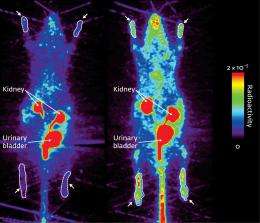Stopping gout in its tracks

Agonizing and debilitating attacks of gout, an inflammatory disease affecting the joints, could soon be consigned to history, thanks to a non-invasive test that can detect the disease before the first painful symptoms strike. Keiji Yashio and Yasuyoshi Watanabe at the RIKEN Center for Molecular Imaging Science at Kobe and their colleagues developed the test that, as well as being useful for diagnosis, could finally reveal exactly what triggers bouts of the disease.
Gout attacks can occur when uric acid levels rise to abnormally high levels in the blood, and then begin to accumulate and crystallize in the lubricating, or synovial, fluid within joints. Patients tend to experience the disease as a series of attacks, and currently there is no way to detect when an attack is about to begin.
To provide a test for the disease, Yashio and Watanabe developed a way to synthesize uric acid labeled with carbon-11, a positron-emitting form of carbon that can be detected by the medical imaging technique called positron emission tomography (PET). Using this tool, medical investigators could scan the body and follow the flows of uric acid around it. If uric acid is beginning to accumulate in the joints, an attack of gout could be imminent, and so preventive medicine can be given.
Yashio and Watanabe successfully tested this idea in rats, showing that the uric acid probe accumulates in the limbs of diseased rats at levels 2.6-fold higher than healthy specimens (Fig. 1). The next step is to test it in people. “Of course, we will test it in gout patients, in remission and in attack,” says Watanabe. The team hopes that their whole-body approach will also allow other uric acid related diseases to be detected in this way. “The PET study could reveal the accumulation of uric acid in the other tissues, such as the kidneys,” he adds. Uric acid build up in the kidney can lead to conditions as serious as renal failure.
Despite decades of study, the relationship between uric acid levels in the blood and the onset of disease symptoms remains unclear. The team’s whole-body snapshots of uric acid distribution may provide the answer. “The PET analysis could clarify whether clearance of uric acid from the kidney in patients is the problem, or whether the problem might be in the circulation of synovial fluid in the cavity of the affected joint,” explains Watanabe.
More information: Yashio, K., et al. Synthesis of [11C]uric acid, using [11C]phosgene, as a possible biomarker in PET imaging for diagnosis of gout. Bioorganic & Medicinal Chemistry Letters 22, 115–119 (2012).
Provided by RIKEN














